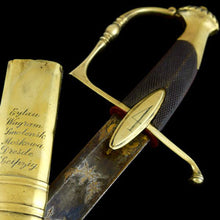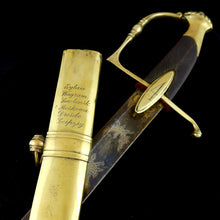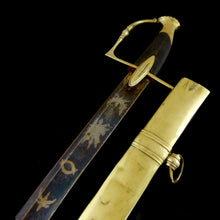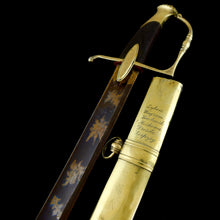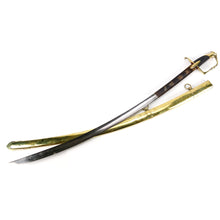Napoleonic First Empire Light Cavalry Officer’s Sabre à la Hongroise, 1810
- Regular price
- £4,900
- Sale price
- £4,900
- Regular price
-
- Unit price
- /per
Adding product to your cart
Overall length: 104cm (41in)
Steel and brass. With bright curved fullered Solingen blade single-edged, etched, blued and gilt with martial trophies. Single branch stirrup hilt with twin langets, the outer engraved ‘4’, square cut, cross hatched wooden grip, fluted brass pommel. Maker’s mark of IS&C under langet for Johan Schimmelbusch et Compagnie; complete in its brass scabbard fitted with twin brass suspension bands and rings and boutrolle (trailing edge) also of brass, the top deeply engraved ‘Eylau, Wagram, Smolensk, Moskowa, Dresden’ and ‘Leipzig’. 85.6 cm. blade
The present sabre was derived from the Hungarian sabres that were adopted by many European armies in the mid eighteenth century. The type was popularized in France during the Consulate period. The brass scabbard of the present example indicates a light cavalry rather than an infantry model which is usually found with a leather scabbard. Known as the 'Cote de Melon’ from the grooved melon shaped pommel, the present type was used by officers in all branches of the Grande Armée's light cavalry arm, but more particularly by Hussar and Chasseur à Cheval officers; the Lancers and Mameluks having their own pattern swords. The langets that were designed to aid returning the sword to its scabbard.
Read more
It is said hussars of Napoleon's army created the tradition of sabrage - the opening of a champagne bottle with a sabre. Wikipedia tells us ‘The technique became popular in France when the army of Napoleon visited many of the aristocratic domains. It was just after the French Revolution and the saber was the weapon of choice for Napoleon's light cavalry (the Hussars). Napoleon's spectacular victories across all Europe gave them plenty of reason to celebrate. During these parties the cavalry would open the champagne with their sabers. Napoleon, who was known to have said, "I drink champagne when I win, to celebrate... and I drink champagne when I lose, to console myself", may have encouraged this.’ It is thus reasonable to assume it was swords of the present type that were the ones Hussar officers originally used. Do not try this at home!






